Leadership Course: Change Management Blog Responses & Discussion
VerifiedAdded on 2023/06/16
|8
|1442
|170
Discussion Board Post
AI Summary
This assignment consists of four blog responses addressing key topics in change management from weeks 1 and 2 of a leadership course. The first two blogs discuss the nature of organizational change, its drivers, and the importance of understanding the scale and scope of change implementation, emphasizing stakeholder satisfaction and resource assessment. The latter two blogs delve into the reasons for change management failures, citing inadequate communication, poor planning, lack of commitment, and strategic missteps using DaimlerChrysler and Microsoft as examples. The assignment highlights the need for effective leadership, clear communication, and thorough planning to mitigate resistance and ensure successful change implementation. Desklib offers access to similar solved assignments and past papers for students.
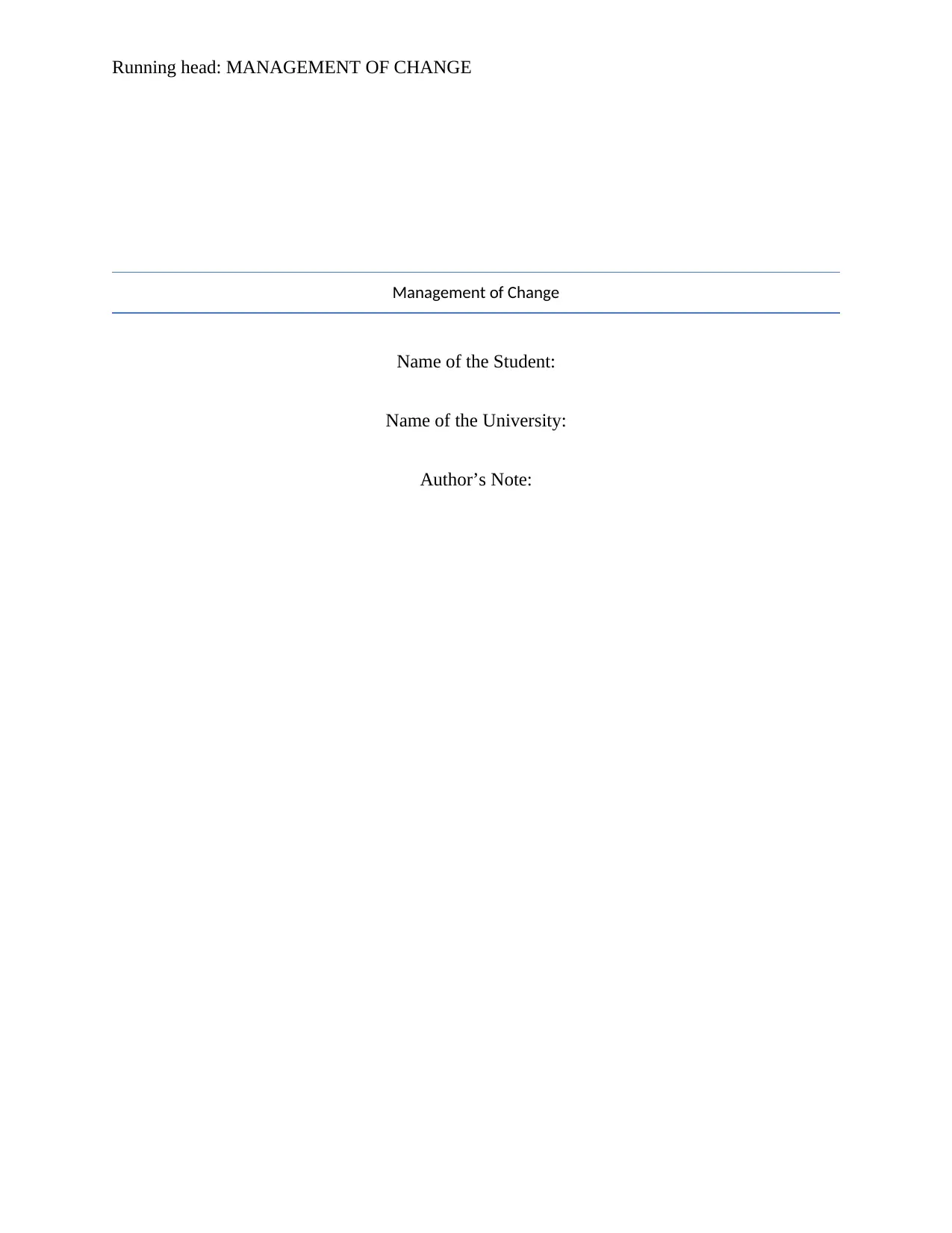
Running head: MANAGEMENT OF CHANGE
Management of Change
Name of the Student:
Name of the University:
Author’s Note:
Management of Change
Name of the Student:
Name of the University:
Author’s Note:
Paraphrase This Document
Need a fresh take? Get an instant paraphrase of this document with our AI Paraphraser
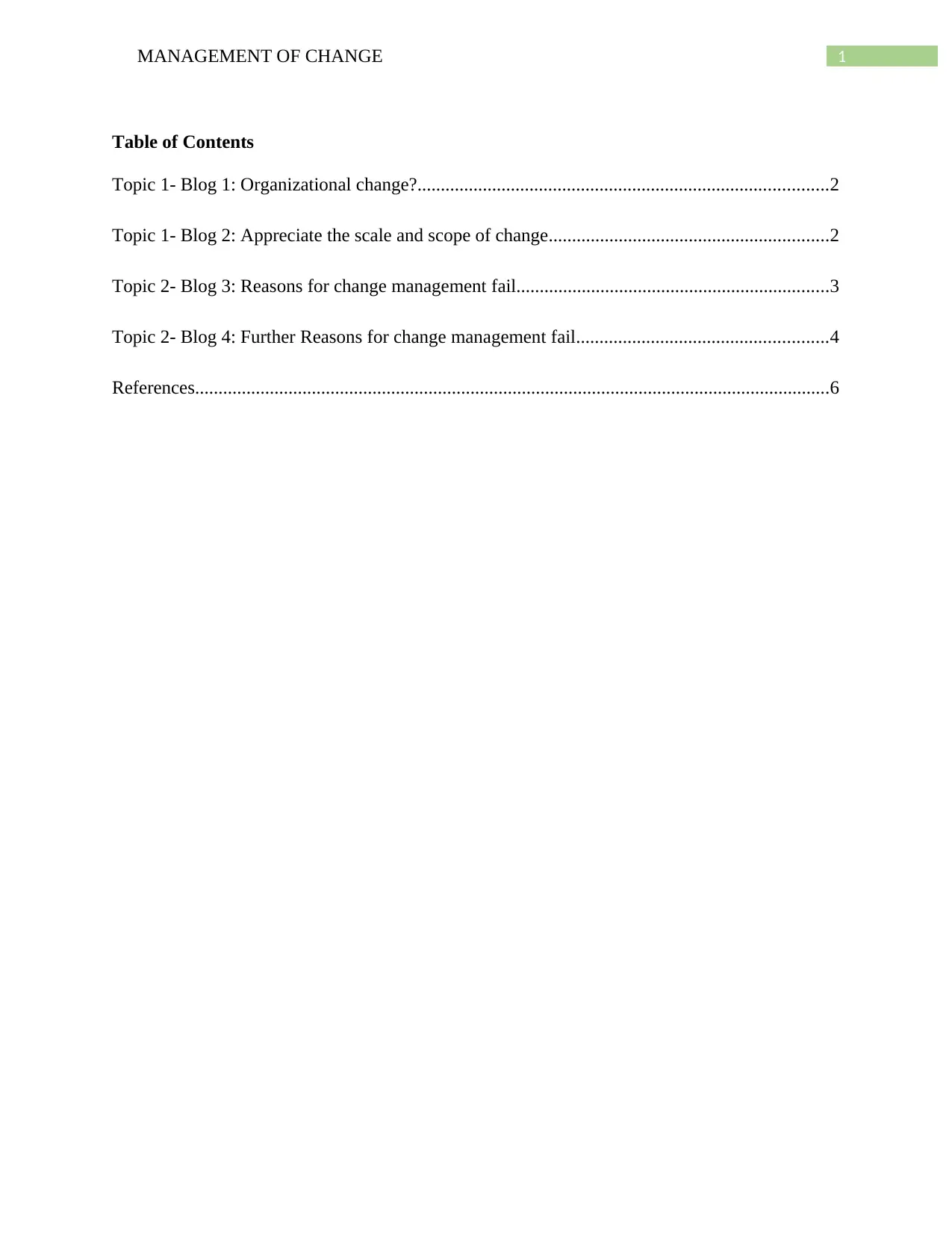
1MANAGEMENT OF CHANGE
Table of Contents
Topic 1- Blog 1: Organizational change?........................................................................................2
Topic 1- Blog 2: Appreciate the scale and scope of change............................................................2
Topic 2- Blog 3: Reasons for change management fail...................................................................3
Topic 2- Blog 4: Further Reasons for change management fail......................................................4
References........................................................................................................................................6
Table of Contents
Topic 1- Blog 1: Organizational change?........................................................................................2
Topic 1- Blog 2: Appreciate the scale and scope of change............................................................2
Topic 2- Blog 3: Reasons for change management fail...................................................................3
Topic 2- Blog 4: Further Reasons for change management fail......................................................4
References........................................................................................................................................6
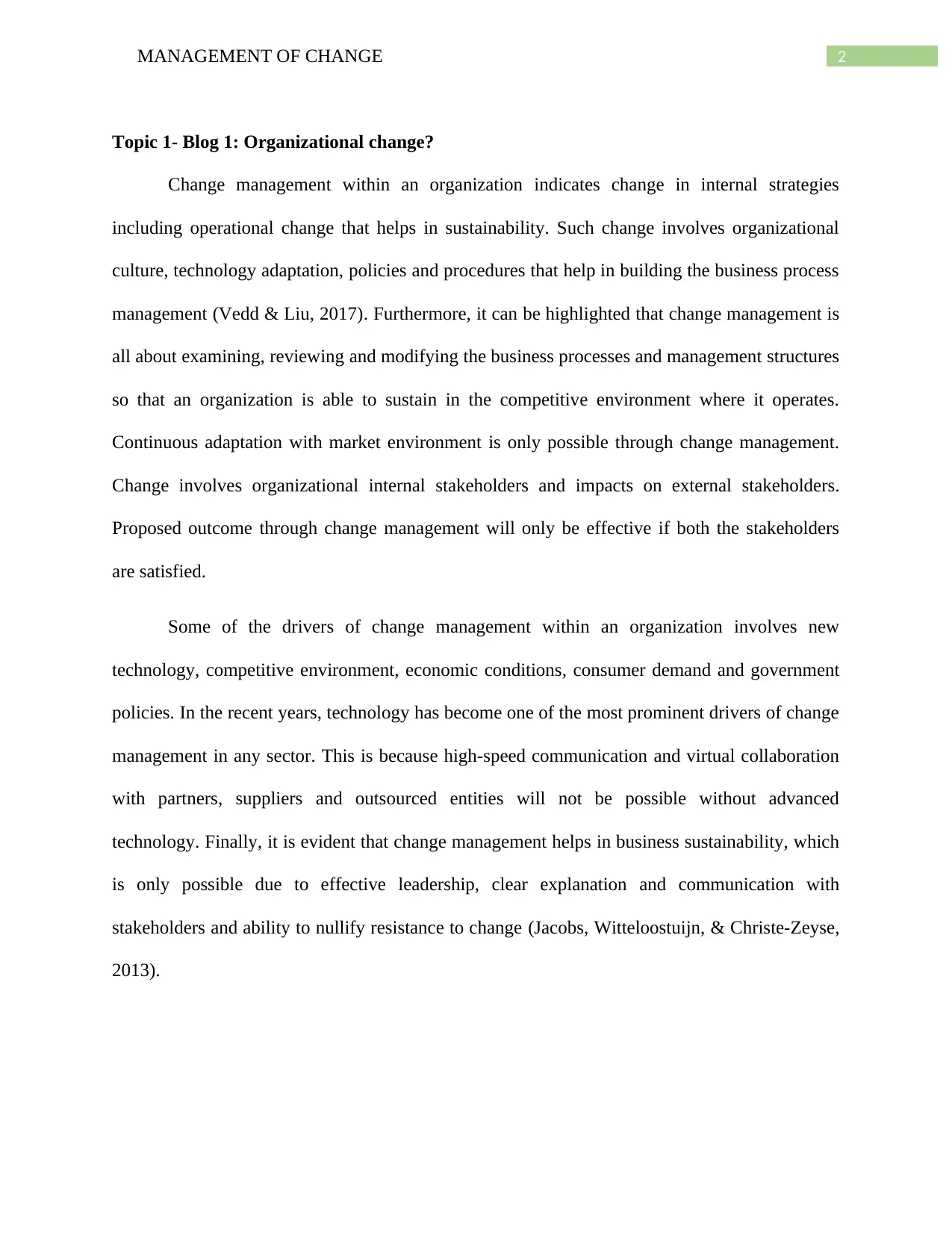
2MANAGEMENT OF CHANGE
Topic 1- Blog 1: Organizational change?
Change management within an organization indicates change in internal strategies
including operational change that helps in sustainability. Such change involves organizational
culture, technology adaptation, policies and procedures that help in building the business process
management (Vedd & Liu, 2017). Furthermore, it can be highlighted that change management is
all about examining, reviewing and modifying the business processes and management structures
so that an organization is able to sustain in the competitive environment where it operates.
Continuous adaptation with market environment is only possible through change management.
Change involves organizational internal stakeholders and impacts on external stakeholders.
Proposed outcome through change management will only be effective if both the stakeholders
are satisfied.
Some of the drivers of change management within an organization involves new
technology, competitive environment, economic conditions, consumer demand and government
policies. In the recent years, technology has become one of the most prominent drivers of change
management in any sector. This is because high-speed communication and virtual collaboration
with partners, suppliers and outsourced entities will not be possible without advanced
technology. Finally, it is evident that change management helps in business sustainability, which
is only possible due to effective leadership, clear explanation and communication with
stakeholders and ability to nullify resistance to change (Jacobs, Witteloostuijn, & Christe-Zeyse,
2013).
Topic 1- Blog 1: Organizational change?
Change management within an organization indicates change in internal strategies
including operational change that helps in sustainability. Such change involves organizational
culture, technology adaptation, policies and procedures that help in building the business process
management (Vedd & Liu, 2017). Furthermore, it can be highlighted that change management is
all about examining, reviewing and modifying the business processes and management structures
so that an organization is able to sustain in the competitive environment where it operates.
Continuous adaptation with market environment is only possible through change management.
Change involves organizational internal stakeholders and impacts on external stakeholders.
Proposed outcome through change management will only be effective if both the stakeholders
are satisfied.
Some of the drivers of change management within an organization involves new
technology, competitive environment, economic conditions, consumer demand and government
policies. In the recent years, technology has become one of the most prominent drivers of change
management in any sector. This is because high-speed communication and virtual collaboration
with partners, suppliers and outsourced entities will not be possible without advanced
technology. Finally, it is evident that change management helps in business sustainability, which
is only possible due to effective leadership, clear explanation and communication with
stakeholders and ability to nullify resistance to change (Jacobs, Witteloostuijn, & Christe-Zeyse,
2013).
⊘ This is a preview!⊘
Do you want full access?
Subscribe today to unlock all pages.

Trusted by 1+ million students worldwide
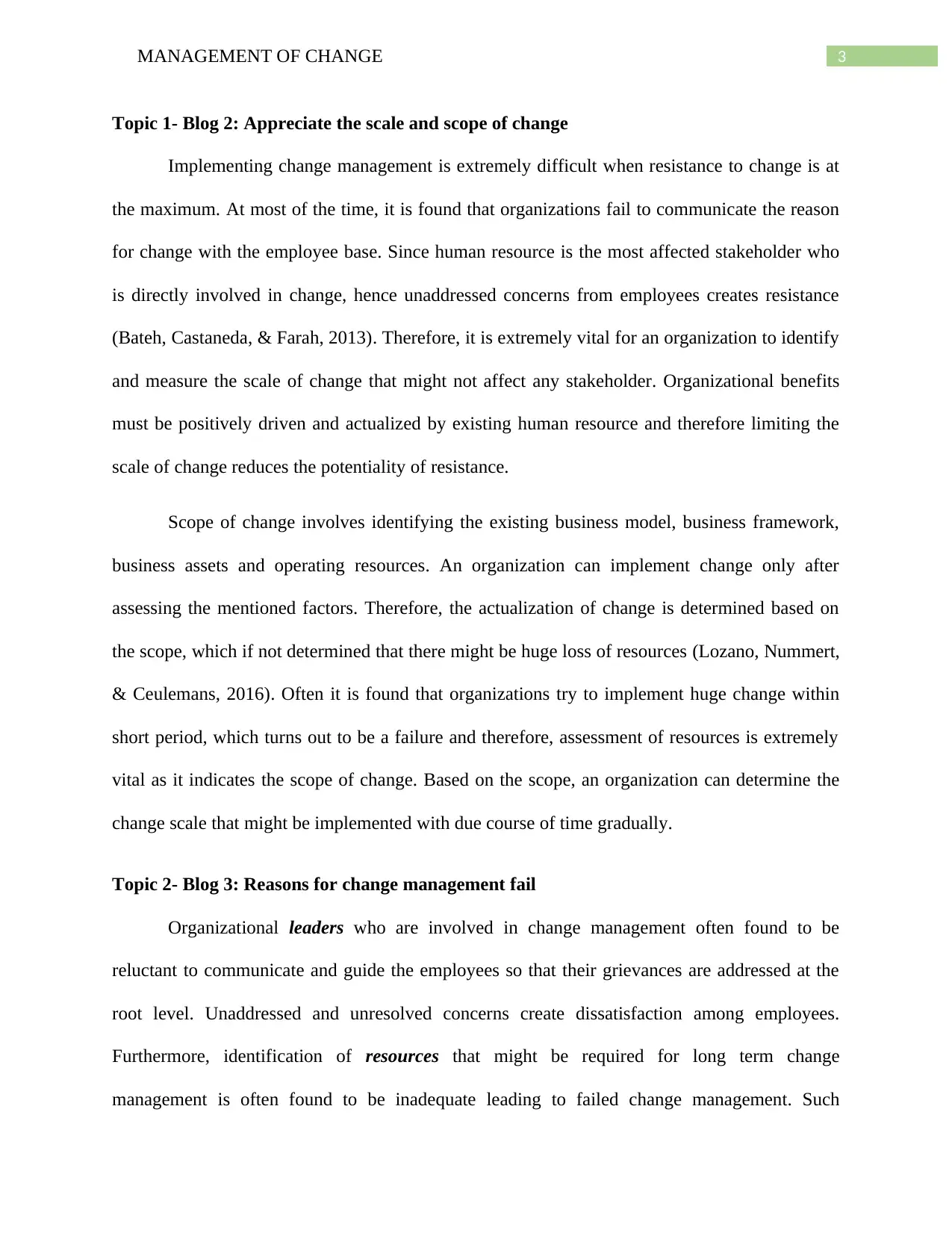
3MANAGEMENT OF CHANGE
Topic 1- Blog 2: Appreciate the scale and scope of change
Implementing change management is extremely difficult when resistance to change is at
the maximum. At most of the time, it is found that organizations fail to communicate the reason
for change with the employee base. Since human resource is the most affected stakeholder who
is directly involved in change, hence unaddressed concerns from employees creates resistance
(Bateh, Castaneda, & Farah, 2013). Therefore, it is extremely vital for an organization to identify
and measure the scale of change that might not affect any stakeholder. Organizational benefits
must be positively driven and actualized by existing human resource and therefore limiting the
scale of change reduces the potentiality of resistance.
Scope of change involves identifying the existing business model, business framework,
business assets and operating resources. An organization can implement change only after
assessing the mentioned factors. Therefore, the actualization of change is determined based on
the scope, which if not determined that there might be huge loss of resources (Lozano, Nummert,
& Ceulemans, 2016). Often it is found that organizations try to implement huge change within
short period, which turns out to be a failure and therefore, assessment of resources is extremely
vital as it indicates the scope of change. Based on the scope, an organization can determine the
change scale that might be implemented with due course of time gradually.
Topic 2- Blog 3: Reasons for change management fail
Organizational leaders who are involved in change management often found to be
reluctant to communicate and guide the employees so that their grievances are addressed at the
root level. Unaddressed and unresolved concerns create dissatisfaction among employees.
Furthermore, identification of resources that might be required for long term change
management is often found to be inadequate leading to failed change management. Such
Topic 1- Blog 2: Appreciate the scale and scope of change
Implementing change management is extremely difficult when resistance to change is at
the maximum. At most of the time, it is found that organizations fail to communicate the reason
for change with the employee base. Since human resource is the most affected stakeholder who
is directly involved in change, hence unaddressed concerns from employees creates resistance
(Bateh, Castaneda, & Farah, 2013). Therefore, it is extremely vital for an organization to identify
and measure the scale of change that might not affect any stakeholder. Organizational benefits
must be positively driven and actualized by existing human resource and therefore limiting the
scale of change reduces the potentiality of resistance.
Scope of change involves identifying the existing business model, business framework,
business assets and operating resources. An organization can implement change only after
assessing the mentioned factors. Therefore, the actualization of change is determined based on
the scope, which if not determined that there might be huge loss of resources (Lozano, Nummert,
& Ceulemans, 2016). Often it is found that organizations try to implement huge change within
short period, which turns out to be a failure and therefore, assessment of resources is extremely
vital as it indicates the scope of change. Based on the scope, an organization can determine the
change scale that might be implemented with due course of time gradually.
Topic 2- Blog 3: Reasons for change management fail
Organizational leaders who are involved in change management often found to be
reluctant to communicate and guide the employees so that their grievances are addressed at the
root level. Unaddressed and unresolved concerns create dissatisfaction among employees.
Furthermore, identification of resources that might be required for long term change
management is often found to be inadequate leading to failed change management. Such
Paraphrase This Document
Need a fresh take? Get an instant paraphrase of this document with our AI Paraphraser
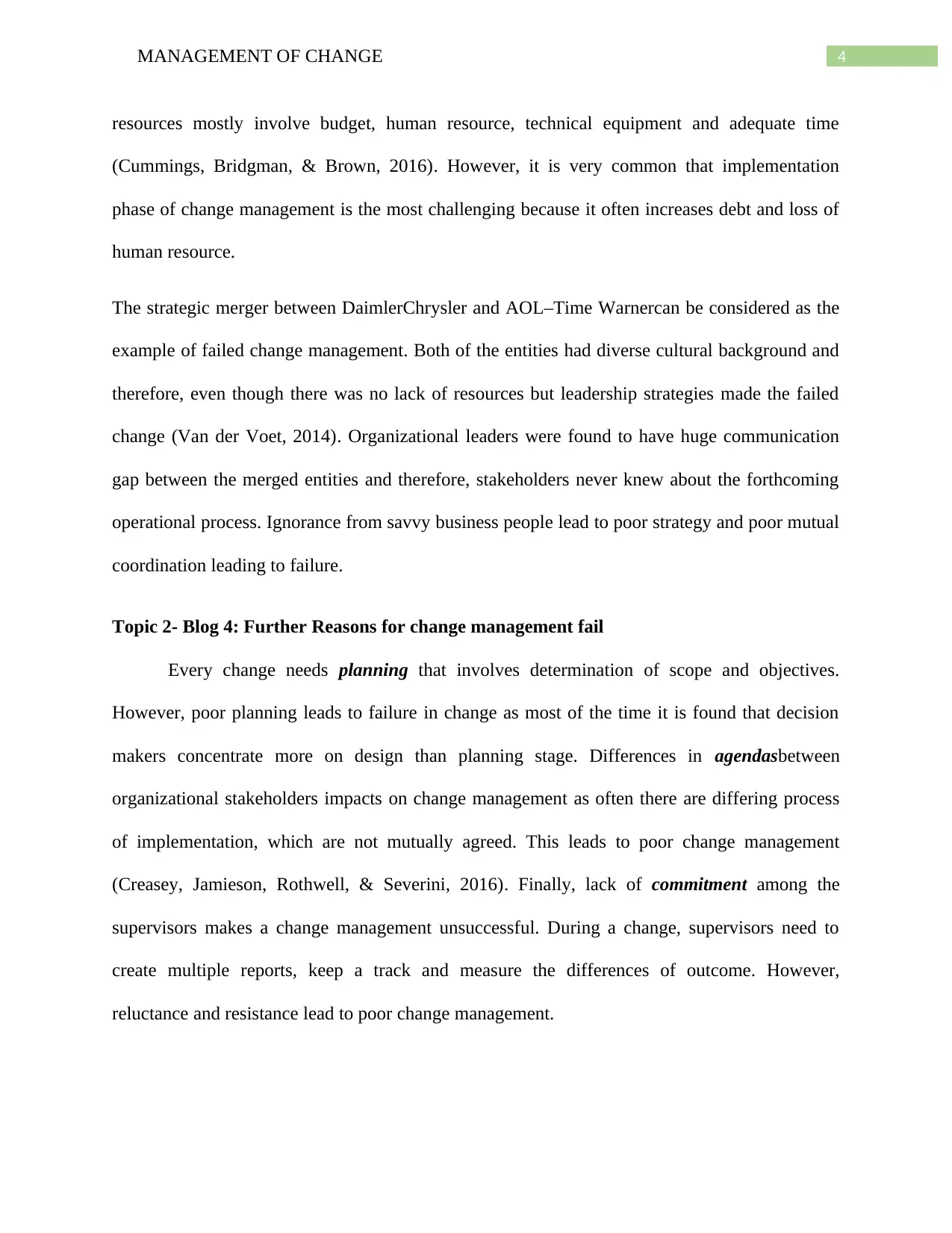
4MANAGEMENT OF CHANGE
resources mostly involve budget, human resource, technical equipment and adequate time
(Cummings, Bridgman, & Brown, 2016). However, it is very common that implementation
phase of change management is the most challenging because it often increases debt and loss of
human resource.
The strategic merger between DaimlerChrysler and AOL–Time Warnercan be considered as the
example of failed change management. Both of the entities had diverse cultural background and
therefore, even though there was no lack of resources but leadership strategies made the failed
change (Van der Voet, 2014). Organizational leaders were found to have huge communication
gap between the merged entities and therefore, stakeholders never knew about the forthcoming
operational process. Ignorance from savvy business people lead to poor strategy and poor mutual
coordination leading to failure.
Topic 2- Blog 4: Further Reasons for change management fail
Every change needs planning that involves determination of scope and objectives.
However, poor planning leads to failure in change as most of the time it is found that decision
makers concentrate more on design than planning stage. Differences in agendasbetween
organizational stakeholders impacts on change management as often there are differing process
of implementation, which are not mutually agreed. This leads to poor change management
(Creasey, Jamieson, Rothwell, & Severini, 2016). Finally, lack of commitment among the
supervisors makes a change management unsuccessful. During a change, supervisors need to
create multiple reports, keep a track and measure the differences of outcome. However,
reluctance and resistance lead to poor change management.
resources mostly involve budget, human resource, technical equipment and adequate time
(Cummings, Bridgman, & Brown, 2016). However, it is very common that implementation
phase of change management is the most challenging because it often increases debt and loss of
human resource.
The strategic merger between DaimlerChrysler and AOL–Time Warnercan be considered as the
example of failed change management. Both of the entities had diverse cultural background and
therefore, even though there was no lack of resources but leadership strategies made the failed
change (Van der Voet, 2014). Organizational leaders were found to have huge communication
gap between the merged entities and therefore, stakeholders never knew about the forthcoming
operational process. Ignorance from savvy business people lead to poor strategy and poor mutual
coordination leading to failure.
Topic 2- Blog 4: Further Reasons for change management fail
Every change needs planning that involves determination of scope and objectives.
However, poor planning leads to failure in change as most of the time it is found that decision
makers concentrate more on design than planning stage. Differences in agendasbetween
organizational stakeholders impacts on change management as often there are differing process
of implementation, which are not mutually agreed. This leads to poor change management
(Creasey, Jamieson, Rothwell, & Severini, 2016). Finally, lack of commitment among the
supervisors makes a change management unsuccessful. During a change, supervisors need to
create multiple reports, keep a track and measure the differences of outcome. However,
reluctance and resistance lead to poor change management.
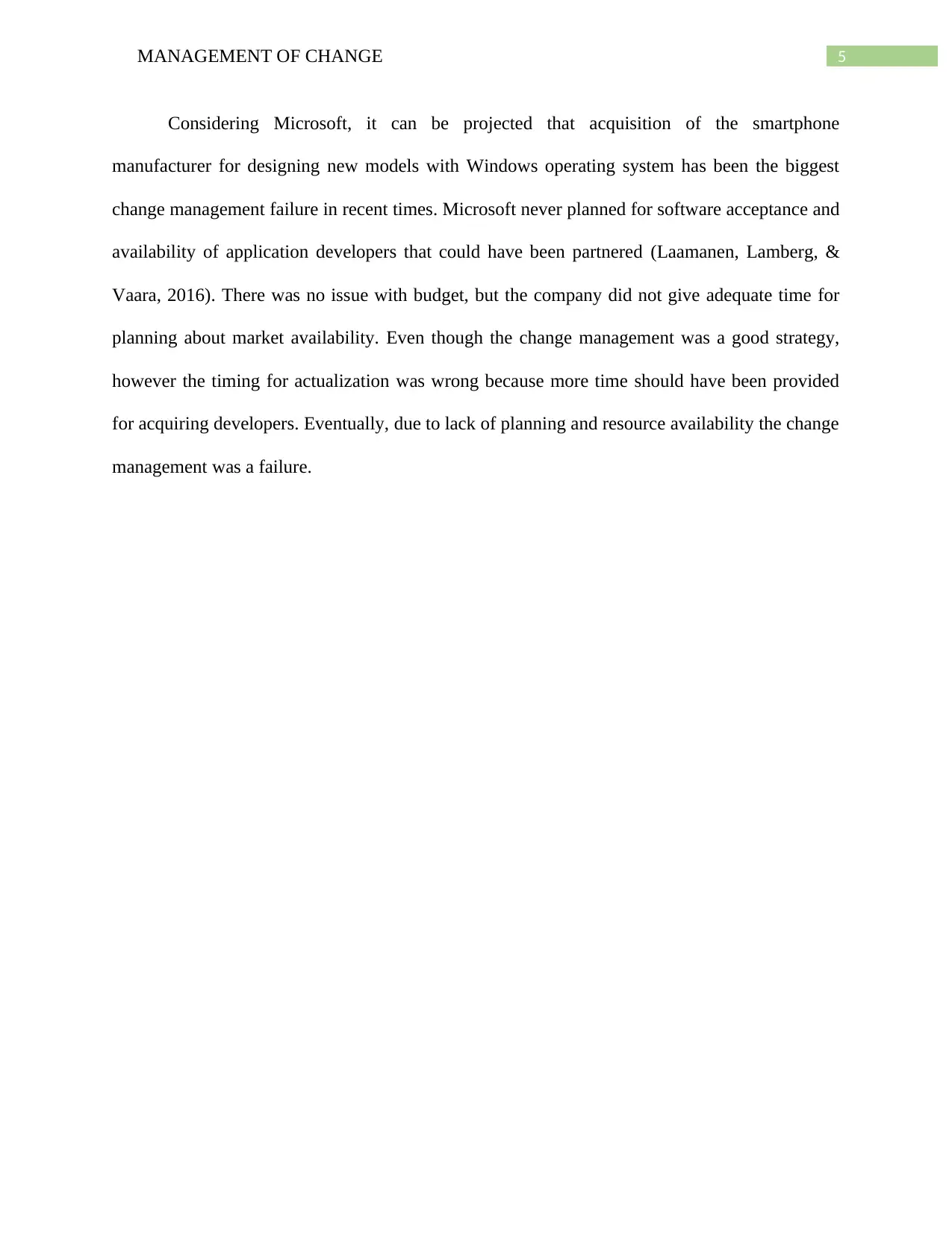
5MANAGEMENT OF CHANGE
Considering Microsoft, it can be projected that acquisition of the smartphone
manufacturer for designing new models with Windows operating system has been the biggest
change management failure in recent times. Microsoft never planned for software acceptance and
availability of application developers that could have been partnered (Laamanen, Lamberg, &
Vaara, 2016). There was no issue with budget, but the company did not give adequate time for
planning about market availability. Even though the change management was a good strategy,
however the timing for actualization was wrong because more time should have been provided
for acquiring developers. Eventually, due to lack of planning and resource availability the change
management was a failure.
Considering Microsoft, it can be projected that acquisition of the smartphone
manufacturer for designing new models with Windows operating system has been the biggest
change management failure in recent times. Microsoft never planned for software acceptance and
availability of application developers that could have been partnered (Laamanen, Lamberg, &
Vaara, 2016). There was no issue with budget, but the company did not give adequate time for
planning about market availability. Even though the change management was a good strategy,
however the timing for actualization was wrong because more time should have been provided
for acquiring developers. Eventually, due to lack of planning and resource availability the change
management was a failure.
⊘ This is a preview!⊘
Do you want full access?
Subscribe today to unlock all pages.

Trusted by 1+ million students worldwide
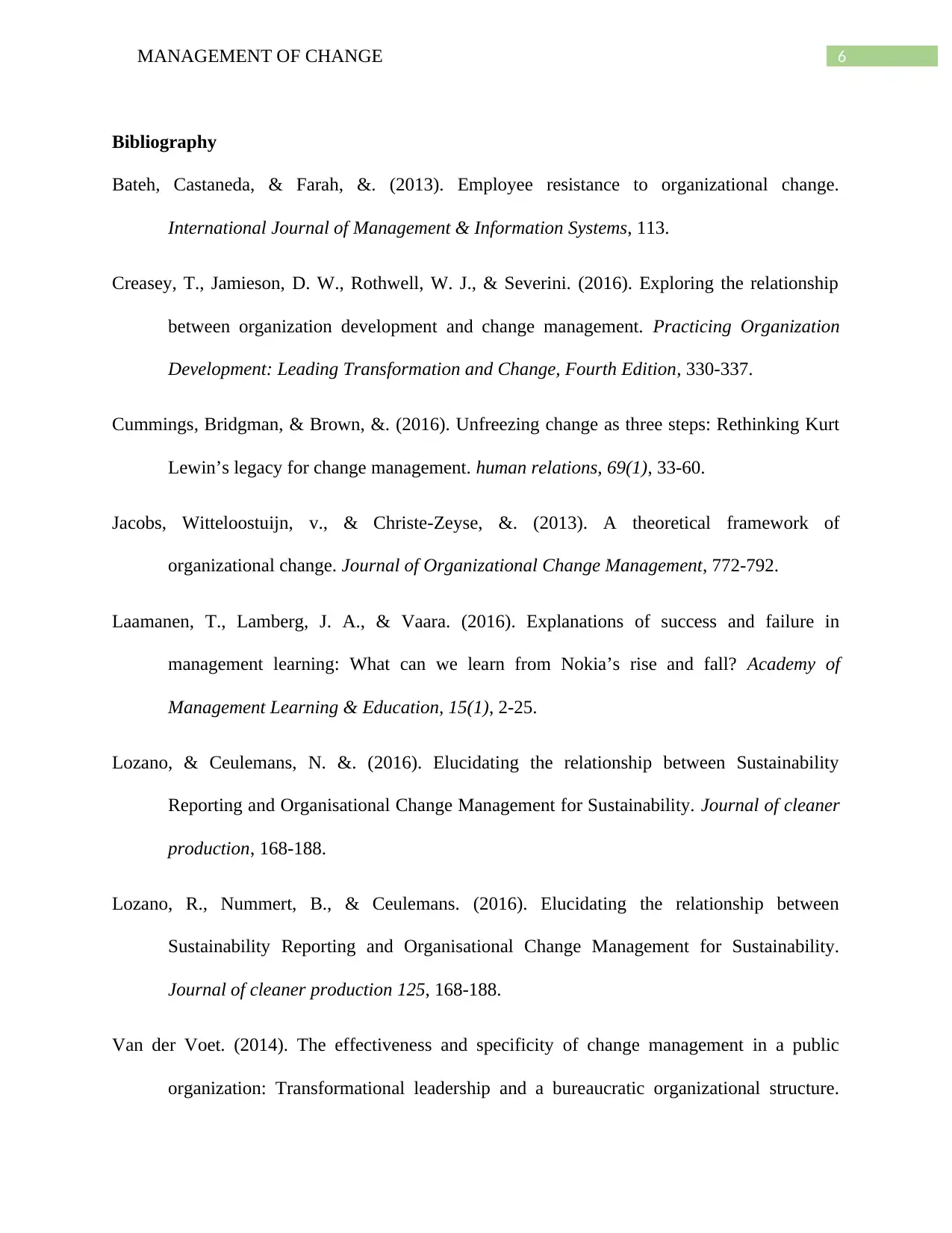
6MANAGEMENT OF CHANGE
Bibliography
Bateh, Castaneda, & Farah, &. (2013). Employee resistance to organizational change.
International Journal of Management & Information Systems, 113.
Creasey, T., Jamieson, D. W., Rothwell, W. J., & Severini. (2016). Exploring the relationship
between organization development and change management. Practicing Organization
Development: Leading Transformation and Change, Fourth Edition, 330-337.
Cummings, Bridgman, & Brown, &. (2016). Unfreezing change as three steps: Rethinking Kurt
Lewin’s legacy for change management. human relations, 69(1), 33-60.
Jacobs, Witteloostuijn, v., & Christe-Zeyse, &. (2013). A theoretical framework of
organizational change. Journal of Organizational Change Management, 772-792.
Laamanen, T., Lamberg, J. A., & Vaara. (2016). Explanations of success and failure in
management learning: What can we learn from Nokia’s rise and fall? Academy of
Management Learning & Education, 15(1), 2-25.
Lozano, & Ceulemans, N. &. (2016). Elucidating the relationship between Sustainability
Reporting and Organisational Change Management for Sustainability. Journal of cleaner
production, 168-188.
Lozano, R., Nummert, B., & Ceulemans. (2016). Elucidating the relationship between
Sustainability Reporting and Organisational Change Management for Sustainability.
Journal of cleaner production 125, 168-188.
Van der Voet. (2014). The effectiveness and specificity of change management in a public
organization: Transformational leadership and a bureaucratic organizational structure.
Bibliography
Bateh, Castaneda, & Farah, &. (2013). Employee resistance to organizational change.
International Journal of Management & Information Systems, 113.
Creasey, T., Jamieson, D. W., Rothwell, W. J., & Severini. (2016). Exploring the relationship
between organization development and change management. Practicing Organization
Development: Leading Transformation and Change, Fourth Edition, 330-337.
Cummings, Bridgman, & Brown, &. (2016). Unfreezing change as three steps: Rethinking Kurt
Lewin’s legacy for change management. human relations, 69(1), 33-60.
Jacobs, Witteloostuijn, v., & Christe-Zeyse, &. (2013). A theoretical framework of
organizational change. Journal of Organizational Change Management, 772-792.
Laamanen, T., Lamberg, J. A., & Vaara. (2016). Explanations of success and failure in
management learning: What can we learn from Nokia’s rise and fall? Academy of
Management Learning & Education, 15(1), 2-25.
Lozano, & Ceulemans, N. &. (2016). Elucidating the relationship between Sustainability
Reporting and Organisational Change Management for Sustainability. Journal of cleaner
production, 168-188.
Lozano, R., Nummert, B., & Ceulemans. (2016). Elucidating the relationship between
Sustainability Reporting and Organisational Change Management for Sustainability.
Journal of cleaner production 125, 168-188.
Van der Voet. (2014). The effectiveness and specificity of change management in a public
organization: Transformational leadership and a bureaucratic organizational structure.
Paraphrase This Document
Need a fresh take? Get an instant paraphrase of this document with our AI Paraphraser
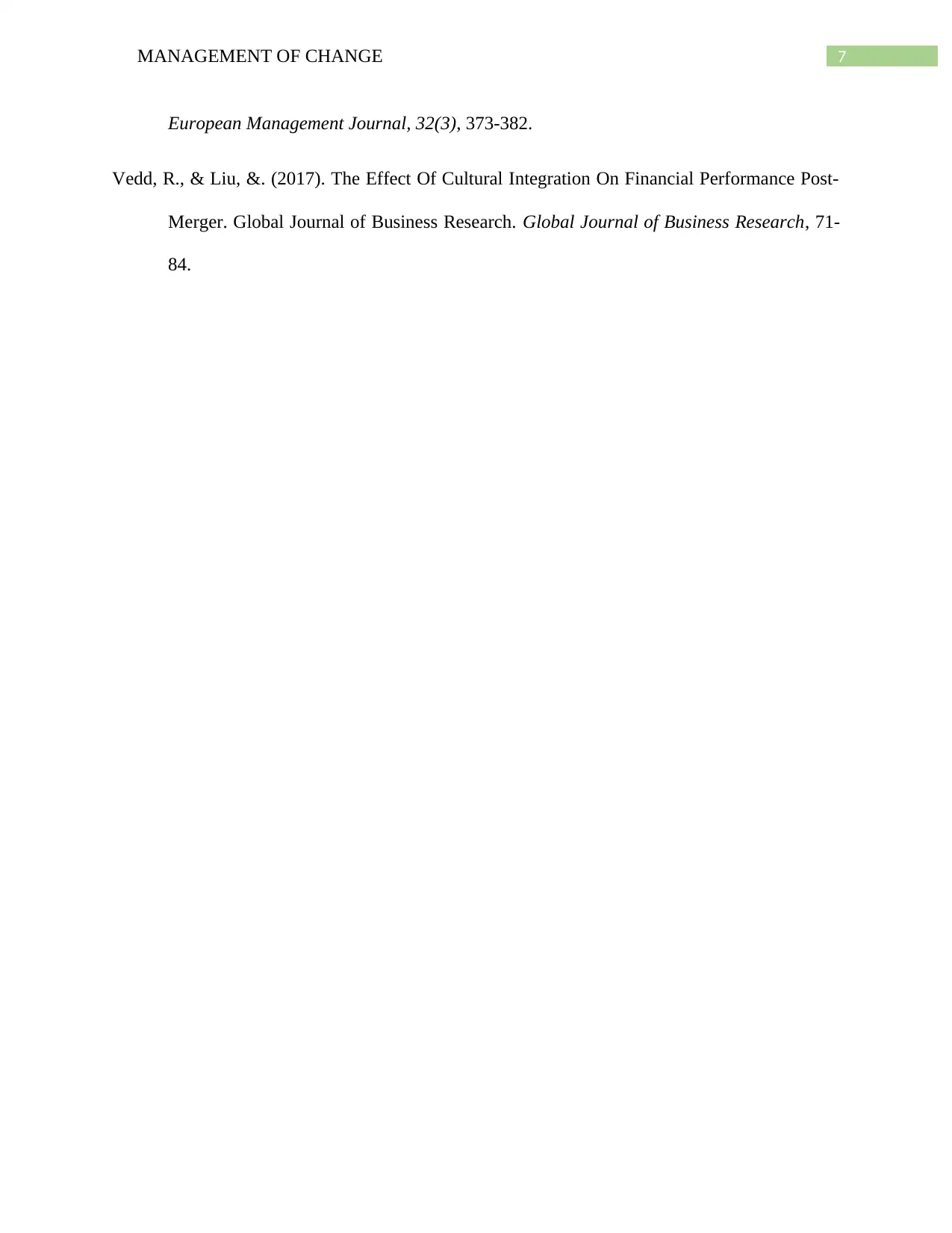
7MANAGEMENT OF CHANGE
European Management Journal, 32(3), 373-382.
Vedd, R., & Liu, &. (2017). The Effect Of Cultural Integration On Financial Performance Post-
Merger. Global Journal of Business Research. Global Journal of Business Research, 71-
84.
European Management Journal, 32(3), 373-382.
Vedd, R., & Liu, &. (2017). The Effect Of Cultural Integration On Financial Performance Post-
Merger. Global Journal of Business Research. Global Journal of Business Research, 71-
84.
1 out of 8
Related Documents
Your All-in-One AI-Powered Toolkit for Academic Success.
+13062052269
info@desklib.com
Available 24*7 on WhatsApp / Email
![[object Object]](/_next/static/media/star-bottom.7253800d.svg)
Unlock your academic potential
Copyright © 2020–2025 A2Z Services. All Rights Reserved. Developed and managed by ZUCOL.



